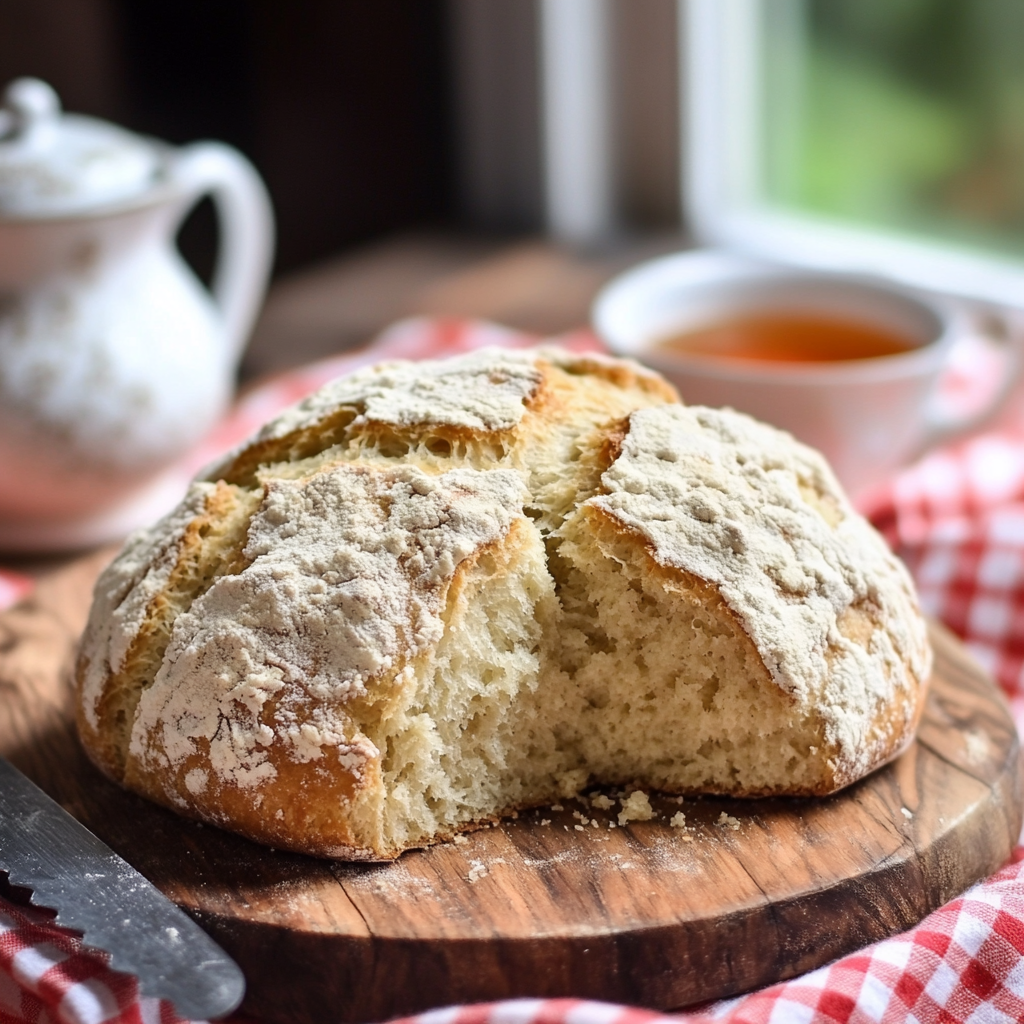Traditional Irish Soda Bread Recipe – Easiest No-Yeast Bread with Just Four Ingredients

Share
Traditional Irish Soda Bread, Likely The Easiest Bread to Make
I first had Irish soda bread at my sisters home, and I was immediately taken by its rustic simplicity. It was warm, hearty, and perfect with a pat of butter. When I found out how easy it was to make, with just four ingredients, I knew this would become a staple in my kitchen. You can make up a loaf of bread in no time—no yeast and no complicated steps. Just mix, shape, and bake! Soda bread is one of those recipes that feels like a small accomplishment every time, and it’s a great way to impress guests with minimal effort.
Did You Know?
Irish soda bread has a rich history dating back to the early 19th century. It was created out of necessity during a time when yeast was scarce. The bread uses baking soda as a leavening agent instead of yeast, which was an accessible and affordable ingredient. Traditionally, it was made with just four ingredients: flour, baking soda, salt, and buttermilk. The cross on the top of the bread is not only decorative but also believed to ward off evil spirits and protect the household. Soda bread is a staple in Irish households and is enjoyed worldwide for its simplicity and rustic flavor.
Yield: 1 loaf
Ingredients:
4 cups all-purpose flour
1 teaspoon baking soda
1 teaspoon salt
1 ¾ cups buttermilk
Instructions:
Prepare the Dough:
Preheat your oven to 425°F (220°C). Lightly grease a baking sheet or cast-iron skillet.
In a large bowl, whisk together the flour, baking soda, and salt.
Make a well in the center of the dry ingredients and pour in the buttermilk.
Using your hands or a wooden spoon, mix until a soft dough forms. The dough should be slightly sticky but manageable.
Personal Tip: Be careful not to overwork the dough; this will keep the bread tender.
Shape the Bread:
Turn the dough onto a lightly floured surface and knead gently for about 1 minute to form a cohesive ball.
Shape the dough into a round loaf and place it on the prepared baking sheet or skillet.
Using a sharp knife, cut a deep cross into the top of the loaf, about ¼ inch deep.
Personal Tip: The cross helps the bread cook evenly and gives it a traditional look.
Bake the Bread:
Bake in the preheated oven for 30-35 minutes, or until the bread is golden brown and sounds hollow when tapped on the bottom.
Transfer to a wire rack to cool completely before slicing.
Personal Tip: If the top browns too quickly, tent the loaf with foil during the last 10 minutes of baking.
Nutritional Information (Per Serving):
Calories: 150, Fat: 1g, Saturated Fat: 0.5g, Carbohydrates: 30g, Fiber: 1g, Sugars: 2g, Protein: 5g
Kitchen Tips, Great Ideas, How to Save Money
-
Buttermilk Substitute: If you don’t have buttermilk on hand, make a substitute by adding 1 tablespoon of lemon juice or white vinegar to 1¾ cups of milk. Let it sit for 5-10 minutes to curdle before using.
-
Whole Wheat Version: For a healthier twist, substitute half of the all-purpose flour with whole wheat flour. It adds more fiber and a slightly nutty flavor to the bread.
-
Add-Ins for Extra Flavor: Experiment by adding raisins, caraway seeds, or currants to the dough for a sweeter or more savory version of soda bread. These ingredients add texture and flavor that complement the simple base.
-
Storing Leftovers: Soda bread can be stored in an airtight container for up to 3 days at room temperature. To extend its shelf life, wrap the loaf in plastic wrap and freeze for up to 2 months. Thaw at room temperature before serving.
-
Soda Bread Variations: Traditional Irish soda bread is savory, but you can also make sweeter versions by adding a little sugar and dried fruit. This variation pairs beautifully with afternoon tea or coffee.
-
Serving Suggestions: Serve soda bread with butter and jam, or alongside hearty soups and stews for a comforting meal. It’s especially good with Irish stew or a simple vegetable soup.
-
Baking Stone Tip: If you have a baking stone, use it for soda bread. The stone retains heat and helps create a crispier crust, making the bread even more rustic and delicious.
-
Avoid Overmixing: To ensure a tender crumb, mix the dough just until the ingredients are combined. Overmixing can result in a tougher texture.
-
Sustainable Practices: Use reusable baking mats instead of parchment paper to reduce waste. For leftovers, opt for glass storage containers to maintain freshness and minimize environmental impact.
-
Using Different Flours: Try experimenting with other flours like rye or spelt to give the bread a unique flavor and texture. Each flour brings its own nutritional benefits and distinct taste.
Let’s Learn About Baking Soda
Baking soda, or sodium bicarbonate, is a leavening agent used in various recipes to help dough rise. It works by reacting with acids (like buttermilk or lemon juice) to produce carbon dioxide, creating air pockets that give bread and cakes a light, airy texture. In addition to its culinary uses, baking soda is a natural cleaning agent. Its mildly abrasive texture makes it perfect for scrubbing surfaces without scratching them. Whether in baking or cleaning, baking soda is an incredibly versatile and eco-friendly ingredient.


